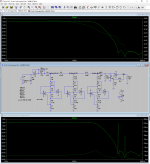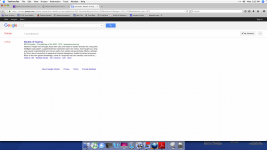Thank you for your response, you highlighted the prominent parts. Should help me in my quest. 🙂This is a serious question....
From the list that Braca suggested, I've taken a part of a 96/24 track.
There are 3 versions.
1) the original 96/24
2) the original BW filtered at 20Khz but still as 96/24, and
3) version 2 but now limited to 16 bits also in 96/24
However, to make things a bit more puzzling, I have added non correlating content above 20Khz to version 2 after BW filtering.
And also did I add non correlating content between 16 and 24 bits to version 3 after having reduced it to 16 bits.
The added non correlating frequency content has roughly the same power spectrum as the original HF spectrum in version 1, so nothing can go wrong with your tweeters.
To my feeling having non correlating content instead of zero content in those frequency and bit bands, should make the difference with version 1) even bigger.
The 3 files are in random order in the dropbox file below as A, B and C.
Let's see what you can make of it.
Hans
Dropbox - DiyAudio - Simplify your life
Hans needs some more results......suspense is killing me! 😛
Remembering the "Kaleidoscope Show" from WRPI; "The show that asks the musical question - are you playing with a full deck?" All that with "No Commercial Potential" :') goes below 92 -
Never was close to there. BTW that was official name of WZBC's programming, "No Commercial Potential" in fact they had several station promos that consisted of distorted loops of "Why do think we call it no commercial potential?"
It got out of hand and WERS took their off-key shows off the air when one of the regents listened in out curiosity. There was a station in Milwaukee that got the same treatment. I mean what's wrong with playing Minor Threat and the Feederz with no bleeps?
This is a serious question. Phase shift is phase shift, whatever the source of it in the audio chain... But, since you ear stops coding for phase at 3.500 Hz or so, it is all completely irrelevant anyways when we discuss 5 degrees at 20 kHz. The human body has no pick up mechanism that decodes for phase at such high frequencies.
This ignores consideration of the ear as a bispectral analyser and the correlations perceivable not only in the steady-state, but also where transient artefacts might audibly manifest themselves. At this point in time, there exists no model of human hearing (AFAIK) that accounts for the audible differences in minimum and excess phase filters, for example, but that model might end up violating Ohm's Acoustical Law (that we are phase insensitive).
In short, if phase shifts bother you, go ahead and correct them. This does not work for distortion, it cannot be corrected... It won't work for audio as matters stand now... No working distortion correction piece of electronics has ever been designed for loudspeakers afaik.
This is far too prescriptive. Distortion is for the most part correctable, although it is not trivial and only in some case is it worthwhile. Klippel's "mirror filters" serve as one example.
I did some more sim runs. I used standard capacitor values.Of course, but the group delay benefit would still be preserved even if you'd scale the networks for a slightly higher cut-off frequency; it is always a compromise between bandwidth and risk of aliasing in a 44.1 kHz system without oversampling ....
4.7nF//3.3nF (=8nF):-3dB@18.5kHz
5nF//2.2nF (=7.2nF):-3dB@20.78kHz
4.7nF//2.2nF (=6.9nF):-3dB@21.71kHz
At the end it depends on the music genre(s), recording technique (did someone say microphone bandwidth? 🙂 ) and ones own listening impressions.
Very true. A lot of variables influence the outcome.
A coincidence. Yesterday and today I was listening to this CD https://www.amazon.com/Verdi-Traviata-Anna-Moffo/dp/B000003GAX
Beautiful performance very dramatic interpretation. The distant miking (very distant to my liking in the beginning, singers sounded recessed) made the recording to sound extremely live, all spatial clues were reproduced through my OB loudspeakers in the living room. I ended loving that recording decision.
I played that CD today morning through my small loudspeakers in close distance, no space signature, almost the same impression I had with the headphones later in the evening.🙂
George
Attachments
It got out of hand and WERS took their off-key shows off the air when one of the regents listened in out curiosity.
I thought WERS is still on air today?
This is far too prescriptive. Distortion is for the most part correctable, although it is not trivial and only in some case is it worthwhile. Klippel's "mirror filters" serve as one example.
I have not seen commercially available implementations of the mirror filters, but as a concept I am sure it works great.
The only serious way to drive distortion of loudspeaker drivers down (except the low end as I mentioned) is by driving down all contributing factors from surround to magnetic assembly. Like Purify has been doing recently.
This ignores consideration of the ear as a bispectral analyser and the correlations perceivable not only in the steady-state, but also where transient artefacts might audibly manifest themselves. At this point in time, there exists no model of human hearing (AFAIK) that accounts for the audible differences in minimum and excess phase filters, for example, but that model might end up violating Ohm's Acoustical Law (that we are phase insensitive).
The audibility of moderate phase shift has not been demonstrated convincingly, but it is easy to fix if you think it might sound better.
...The only serious way to drive distortion of loudspeaker drivers down (except the low end as I mentioned) is by driving down all contributing factors from surround to magnetic assembly. Like Purify has been doing recently.
You appear to omit decades of understanding and innovation. IMHO suspension and surround non-linearity and many other displacement related non-linearities are not of great audible importance if reasonable steps are taken. Rather, ameliorating voice coil current dependent non-linearities has offered the greatest gain in audible transparency in recent times.
The audibility of moderate phase shift has not been demonstrated convincingly, but it is easy to fix if you think it might sound better.
I would argue that it simply has not been measured and analysed to see if it is audible. Second-order measures are not sufficient to describe the (at least) third-order mechanisms our brains employ in our perception. And in that, many artefacts we are known to perceive (or at least report to perceive) remain conspicuous by their absence in the measures we make.
Last edited:
Hi soundbloke, welcome to the discussion. Of course, work on the audibility of 'phase', (group delay) etc has been reported on over the last many decades, but when CD came around, the argument was lost to practicality. Now, we can do better, and 'phase' can be seriously considered. It is just those who want CD to be their last stand on audio quality that make the argument that nothing better matters.
Hi soundbloke, welcome to the discussion.
Thank you 🙂
Of course, work on the audibility of 'phase', (group delay) etc has been reported on over the last many decades....
But none of the previous work (of which I am aware) relates to third-order measures, yet there are many audible differences reported here and elsewhere that do not exceed the thresholds of phase audibility established in second-order analyses.
And somewhat related, we might also like (or not) to consider the delay as our cognitive apparatus converges on a perception. This could have a profound effect on listening tests, for example.
...but when CD came around, the argument was lost to practicality. Now, we can do better, and 'phase' can be seriously considered. It is just those who want CD to be their last stand on audio quality that make the argument that nothing better matters.
Maybe I have mis-read the previous comments? My take on the discussion was a debate concerning the information bandwidth of CD, for which Nyquist established long ago was sufficient for high quality domestic audio (at least if we allow for noise shaped quantization), and, as an adjunct to that debate, the possibility of audible differences due to filtering inherent in the quantisation process?
Actually, it is the rationalization that 44.1KHz (compatible with other Sony products) was a fast enough sampling rate for just about everything.
As far as phase sensitivity is concerned, Manfred Schroeder wrote a wonderful article in 'The Proceedings of the IEEE' in 1975-76 of what hearing was capable of, now 45 years ago. Anyone out there with a copy? I have misplaced mine. Ohm's 'Law of Acoustics' is obsolete, as is stated in that article.
As far as phase sensitivity is concerned, Manfred Schroeder wrote a wonderful article in 'The Proceedings of the IEEE' in 1975-76 of what hearing was capable of, now 45 years ago. Anyone out there with a copy? I have misplaced mine. Ohm's 'Law of Acoustics' is obsolete, as is stated in that article.
Attachments
Last edited:
Ohm's 'Law of Acoustics' is obsolete, as is stated in that article.
I would suggest it is better stated to be limited relevance in a few esoteric considerations, such as those in this thread. The Law remains more than adequate as a model in a substantial number of other applications, however.
Perhaps a second order differential equation of the independent variable phase?
It includes the first order term (phase itself)
It includes the second order term (the first derivative of phase a/k/a frequency)
Now it includes the third order term (the second derivative of phase a/k/a "angular acceleration")
???
It includes the first order term (phase itself)
It includes the second order term (the first derivative of phase a/k/a frequency)
Now it includes the third order term (the second derivative of phase a/k/a "angular acceleration")
???
Last edited:
'Ohm's Law of Acoustics' was too much relied upon, literally, for too many decades, so that it is inaccurate to use it indiscriminately, like around here. There are too many exceptions to it, as shown, for example, by Bell Labs, over 50 years ago.
We haven't talked angular acceleration a lot. Maybe it's time... 🙂
Still, what is it, practically ?
//
Still, what is it, practically ?
//
Last edited:
isn't that when you hit the throttle coming off turn four sideways on the final lap? 😀
Last edited:
- Home
- Member Areas
- The Lounge
- The Black Hole......

